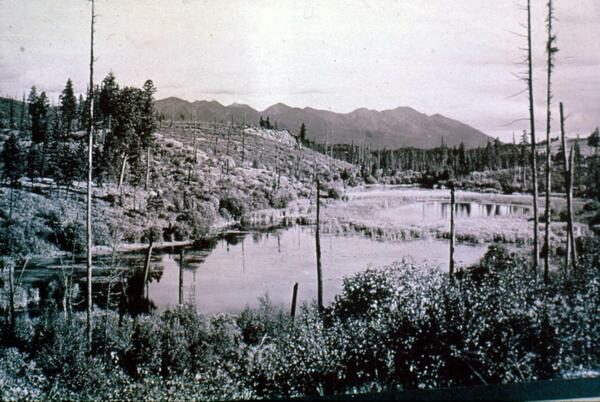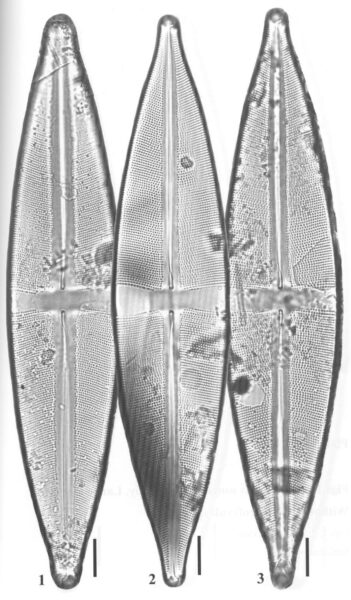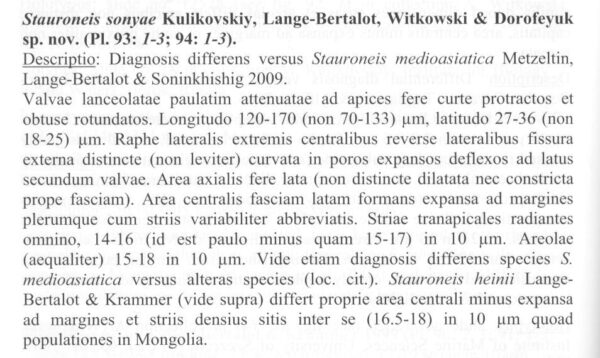Stauroneis sonyae
-
Category
-
Length Range118-177 µm
-
Width Range26-37 µm
-
Striae in 10 µm14-16
-
ContributorLoren Bahls - Dec 2011
-
ReviewerPat Kociolek - Mar 2012
Identification
Description
Valves are elliptic-lanceolate with narrow, short protracted, obtusely rounded apices. The axial area is moderately broad, about 3-4 times wider than the raphe. The stauros is very wide and distinctly expanded toward the valve margins in the shape of a bow tie. The stauros typically contains several short striae along each margin. Raphe fissures are lateral. Proximal raphe ends are strongly inflated and curved toward the secondary side. Terminal raphe fissures are hooked, the hooks opening to the secondary side. Striae are radiate throughout, becoming more radiate toward the valve apices. Areolae are round and distinct, 15-18 in 10 µm.
Autecology
Stauroneis sonyae was found in periphyton samples collected from five lakes, ponds, and fens in western Montana and southwestern Alberta. The pH of these waters ranges from 6.9 to 7.8 and specific conductance ranges from 67 to 1769 µS/cm.
-
Size Range, µm3
-
Motility
-
Attachment
-
Habitat
-
Colony
-
Waterbody
- Learn more about this
Original Description
Description: Differential diagnosis versus Stauroneis medioasiatica Metzeltin, Lange-Bertalot & Soninkhishig 2009. Valves lanceolate tapering to the short-protracted and obtusely rounded ends which are 6-11 µm broad. Length 120-170 (not 70-133) µm, breadth 27-36 (not 18-25) µm. Raphe lateral with reverse lateral central ends; external fissure distinctly (not slightly) curving into clearly expanded pores deflected to the secondary valve side. Axial area rather broad (neither distinctly expanded nor constricted proximally). Central area forming a broad, bow-tie-shaped fascia, in most cases with irregularly shortened marginal striae. Striae radiate throughout, 14-16 (i.e. only slightly less than 15-17) in 10 µm. Areolae in both species 15-18 in 10 µm. cf. also other larger-sized taxa mentioned in the differential diagnosis of S. medioasiatica that are altogether distinguished by another complex of characters. Stauroneis heinii Lange-Bertalot & Krammer (see above) differs mainly by its less expanded central area towards valve margins and denser spaced striae (16.5-18) in 10 µm as far as populations from Mongolia are concerned.
-
AuthorKulikovskiy, Lange-Bert., Witkowski and Dorofeyuk 2010
-
Length Range120-170 µm
-
Width27-36 µm
-
Striae in 10µm14-16
Citations & Links
Citations
Links
Cite This Page
Bahls, L. (2011). Stauroneis sonyae. In Diatoms of North America. Retrieved April 25, 2024, from https://diatoms.org/species/stauroneis_sonyae
Responses
The 15 response plots show an environmental variable (x axis) against the relative abundance (y axis) of Stauroneis sonyae from all the stream reaches where it was present. Note that the relative abundance scale is the same on each plot. Explanation of each environmental variable and units are as follows:
ELEVATION = stream reach elevation (meters)
STRAHLER = distribution plot of the Strahler Stream Order
SLOPE = stream reach gradient (degrees)
W1_HALL = an index that is a measure of streamside (riparian) human activity that ranges from 0 - 10, with a value of 0 indicating of minimal disturbance to a value of 10 indicating severe disturbance.
PHSTVL = pH measured in a sealed syringe sample (pH units)
log_COND = log concentration of specific conductivity (µS/cm)
log_PTL = log concentration of total phosphorus (µg/L)
log_NO3 = log concentration of nitrate (µeq/L)
log_DOC = log concentration of dissolved organic carbon (mg/L)
log_SIO2 = log concentration of silicon (mg/L)
log_NA = log concentration of sodium (µeq/L)
log_HCO3 = log concentration of the bicarbonate ion (µeq/L)
EMBED = percent of the stream substrate that is embedded by sand and fine sediment
log_TURBIDITY = log of turbidity, a measure of cloudiness of water, in nephelometric turbidity units (NTU).
DISTOT = an index of total human disturbance in the watershed that ranges from 1 - 100, with a value of 0 indicating of minimal disturbance to a value of 100 indicating severe disturbance.

Stauroneis sonyae
- Valves large, elliptic-lanceolate
- Apices narrow, subrostrate
- Axial area 3-4 times wider than raphe
- Stauros wide, bow tie shaped
- Proximal raphe ends curved and strongly dilated
Stauroneis sonyae has large elliptic-lanceolate valves with narrow subrostrate apices. The axial area is 3-4 times wider than the raphe. The stauros is very wide, shaped like a bow tie, and usually with short striae at the margins. Proximal raphe ends are curved and strongly dilated.
 Diatoms of North America
Diatoms of North America








